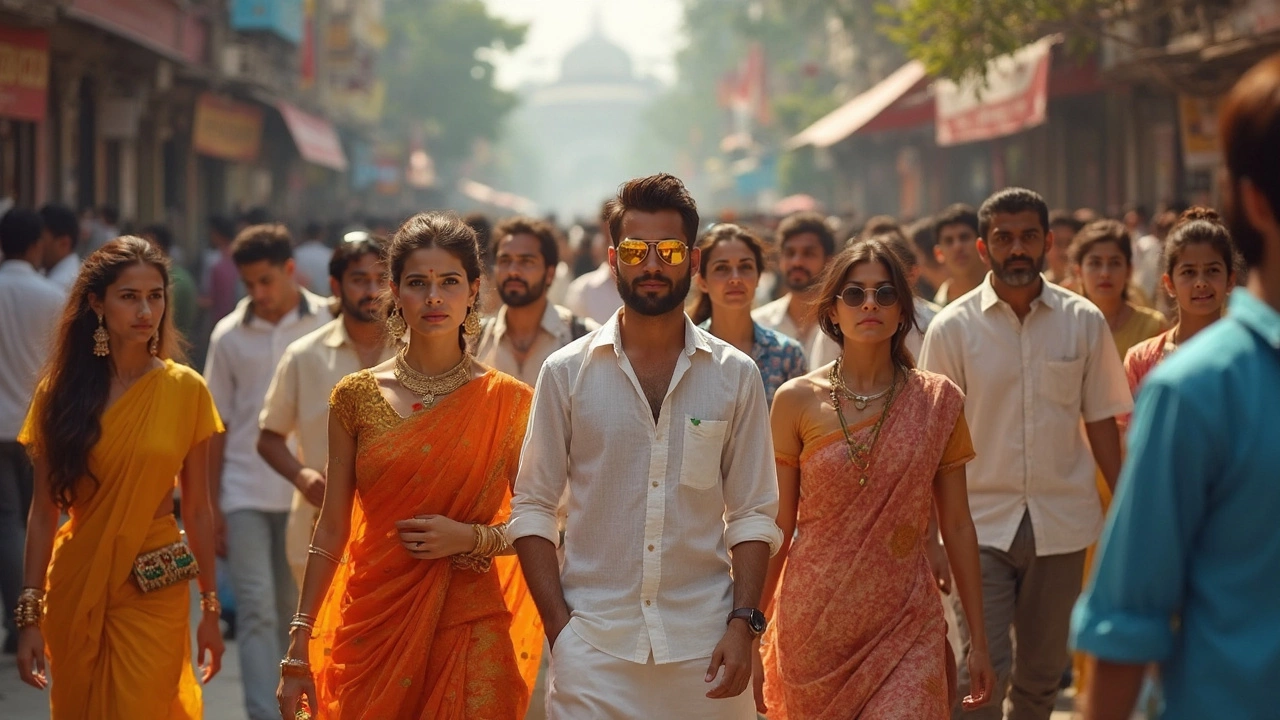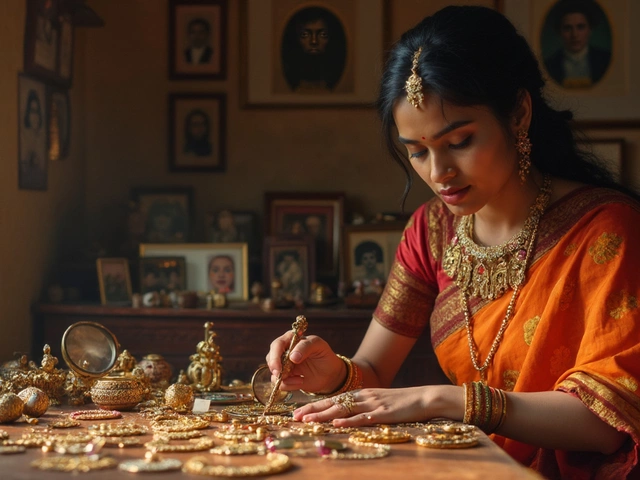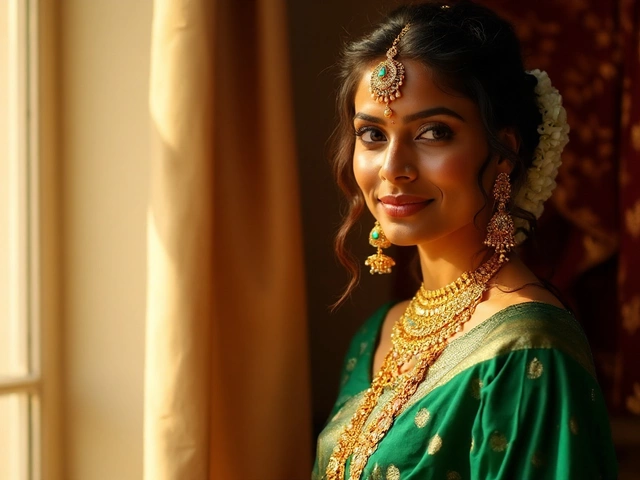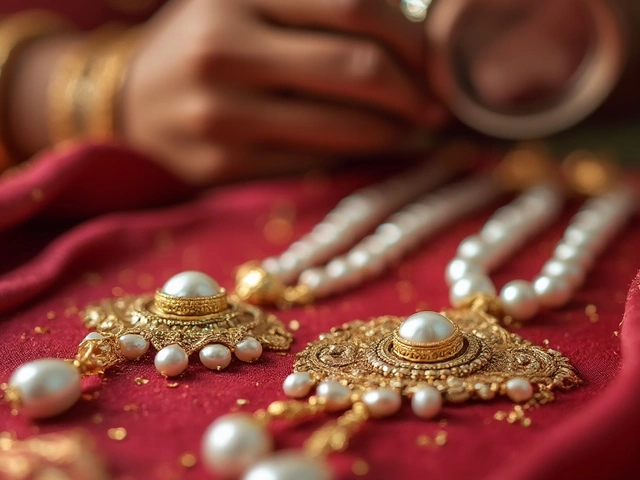Ever wondered why some folks in India look perfectly put together for the occasion, while others stick out like a sore thumb? It all comes down to knowing the basics of Indian dress etiquette. A single accessory—like a modest scarf or the right pair of shoes—can totally change how people see you here.
India isn’t a place where one-size-fits-all works with clothes. What’s cool and normal at a Delhi mall might raise eyebrows in a small Rajasthan village. Traditional outfits like saris or kurta-pajamas still rule at festivals or family gatherings, but don’t be surprised to see jeans and tees on college campuses everywhere.
If you’re thinking about visiting or just want to level up your style game, adding the right accessory—think a classy dupatta, chunky silver bangles, or a simple jhola bag—can help. Dress codes in India aren’t just about style; they often reflect respect for traditions, religions, and local vibes.
Sounds complicated? It's actually practical once you know the ropes. Let’s break it down so you never have a “what should I wear?” panic again.
- Why Dress Etiquette Matters in India
- Traditional and Modern Clothing: What Works Where
- Fashion Accessories: The Little Details That Count
- Tips for Travelers and City Dwellers
- Common Mistakes and How to Avoid Them
Why Dress Etiquette Matters in India
If you’re in India and you care even a little about making a good impression, dress etiquette India is something you can’t ignore. First impressions here are big—most people form opinions based on what you’re wearing before you even open your mouth. It’s not just about fashion; it’s tied to respect, culture, and even safety.
In India, clothes send an instant signal about where you’re from, how much you respect local customs, and if you’re aware of your surroundings. For example, showing too much skin can be a big no-no in rural areas and at religious sites, while in some cities, Western outfits are totally fine. Think of wedding invites, temple visits, or even work events—there’s always an unwritten dress code and sometimes a very clear, loud-and-clear written one.
Fun fact: In metro cities like Mumbai and Bangalore, people switch between traditional and modern outfits depending on the day. At big festivals like Diwali or Eid, you’ll see almost everyone—young and old—dressed in saris, salwar suits, or kurta-pajamas. But on a Friday night, the same crowd might choose jeans and branded t-shirts for dinner out.
Here’s why these unwritten rules matter:
- Indian fashion helps you blend in and avoid awkward stares, especially outside tourist zones.
- Picking the right outfit can open doors—literally. You won’t get into many temples or official buildings in shorts, tank tops, or very tight clothes.
- Respecting traditional clothing isn’t just polite—it’s expected at weddings, ceremonies, and family get-togethers.
- Knowing the scene saves you time and hassle—no scrambling for a scarf last minute or getting side-eyed by relatives.
Here’s a quick table breaking down where dress etiquette shifts a lot:
| Setting | Expected Dress |
|---|---|
| Temple or religious event | Covered shoulders & knees, often traditional wear |
| Office or business meeting | Formal wear (saree, salwar, shirt, trousers) |
| Casual outing in cities | Jeans, t-shirts, or Indo-Western fusion |
| Village or rural area | Very modest, mostly traditional outfits |
So, knowing what to wear isn’t about following old rules—it’s about common sense, good manners, and showing you understand what’s important to the people around you. That’s why figuring out dress etiquette India pays off, whether you’re working, touring, or just looking to fit in.
Traditional and Modern Clothing: What Works Where
If you want to crack Indian dress etiquette, you’ll need to know when to bring out the classics and when you can just go casual. India’s all about a mix—think saris, salwar-kameez, and lehengas for women, or kurta-pajamas and sherwanis for men, but jeans and tees have definitely made their mark in daily life, especially among the young crowd in cities.
In villages or religious places, traditional clothes are the safe bet. Big family functions, weddings, or festivals like Diwali? Expect everyone to look their ethnic best. Urban spots and offices are a different game—many folks wear Western clothes, but often adapt them based on the day and the occasion. For example, "Ethnic Fridays" are actually a thing in many tech offices in Bangalore and Hyderabad, where people ditch the formals for vibrant kurtas and sarees.
"Indian fashion isn’t about ancient vs. modern—it’s about blending both to match the moment," says designer Ritu Kumar, who’s dressed everyone from Bollywood stars to Ambani wedding guests.
A few key points to remember when deciding what to wear in India:
- Festivals and Family Events: Go traditional. Women usually pick saris or salwar-kameez; men go for kurta-pajamas or even a Nehru jacket for some extra flair.
- Temples and Holy Places: Dress conservative. Long sleeves, covered legs, and don’t forget to carry a scarf or shawl if you’re a woman. No sleeveless tops or shorts for anyone. Footwear stays outside.
- Urban Areas and Colleges: Western wear is totally fine—just skip anything too revealing. In Mumbai or Bangalore, you’ll find everything from ripped jeans to t-shirts and even business suits depending on the occasion.
- Villages and Small Towns: The vibe here is more conservative. Best to stick with full-length clothes, and women usually wear Indian outfits like sarees or suits.
Here’s a quick look at what’s popular in different places:
| Occasion/Location | Common Outfits |
|---|---|
| City Offices | Formal shirts, trousers, sarees, Western dresses |
| Temples | Saris, salwar kameez, kurta-pajama (with heads sometimes covered) |
| Weddings | Heavy sarees, lehengas, sherwanis, Nehru jackets |
| Colleges | Jeans, t-shirts, casual kurtas |
| Villages | Saris, salwar suits, kurta-pajamas |
The bottom line? There's a time and place for every look in India, so check your plans and go with the flow. You don't have to go full Bollywood, but knowing these basics saves you from a lot of awkwardness.
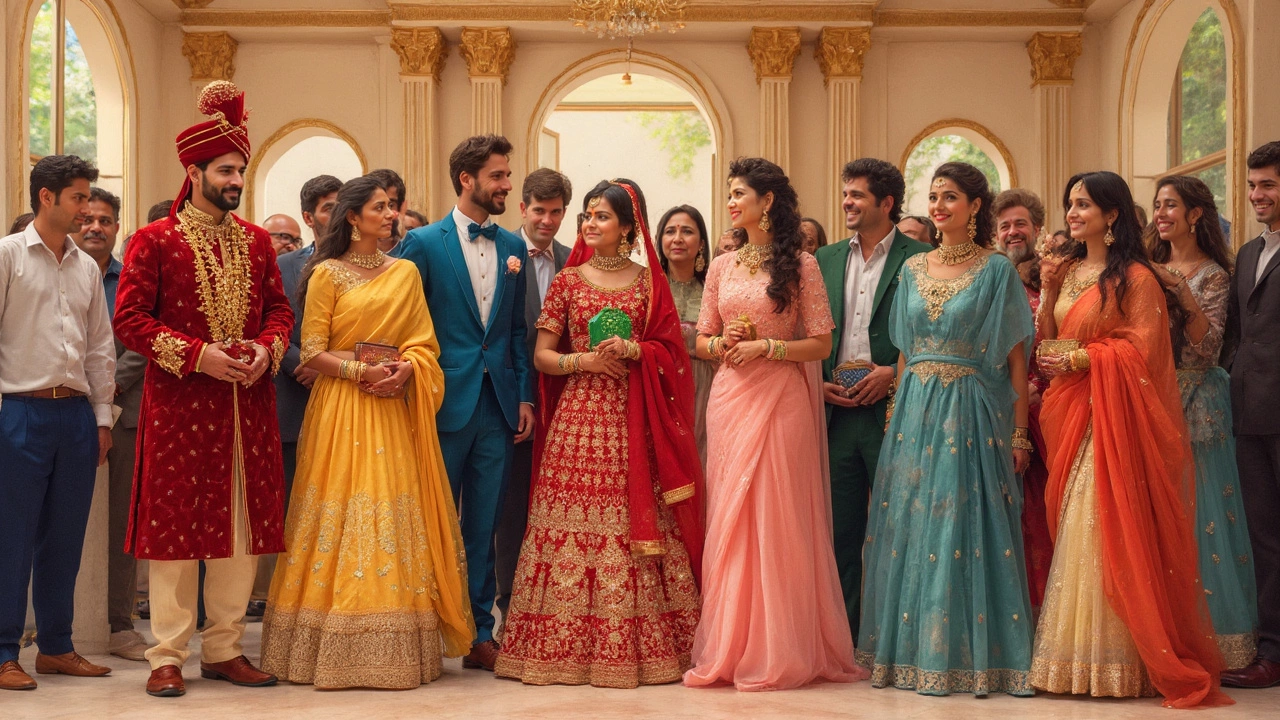
Fashion Accessories: The Little Details That Count
Getting the dress etiquette in India right isn’t just about the clothes. Accessories can make or break your look—and sometimes, your reputation. In most Indian settings, especially formal events and traditional gatherings, what you add to your outfit speaks volumes. So let’s crack the code on the most important accessories.
- Dupatta or Scarf: This is a big one for women. Whether you’re wearing a salwar kameez or lehenga, a dupatta isn’t just decoration—it’s expected and often used to cover your shoulders or head in religious spaces. Guys, you’ll see many grooms rock a matching stole with their sherwani during weddings too.
- Jewelry: In India, gold still rules at weddings. Chunky bangles, long necklaces, and jhumka earrings are everywhere. Everyday wear leans towards silver, oxidized, or beaded pieces—these are a top pick among college students or anyone wanting a boho vibe.
- Bindi: A tiny dot on the forehead isn’t just stylish. For married women, it’s almost mandatory, while for others, it’s a fun accessory you’ll spot at more traditional events.
- Footwear: For any formal or religious occasion, covered shoes or simple sandals do the trick for men. Women have way more options: kolhapuris, juttis, mojaris—all classic choices that pair well with Indian outfits, and you’ll see them everywhere from weddings to festivals.
- Bags: Leave your big, flashy totes at home if you’re heading to a traditional function. Instead, use small clutches, potli bags (embroidered and super practical), or even a simple jhola if you want something casual.
Fashion accessories in India are also about comfort and staying cool. Wide-brim hats aren’t really the trend, but sunglasses are a must on hot, sunny days. For daily commutes, especially on crowded trains or metros, crossbody bags are way safer against pickpockets.
| Accessory | Where It's Most Common | When to Use |
|---|---|---|
| Dupatta | Across India | Festivals, temples, family gatherings |
| Kolhapuri Chappals | Maharashtra, Urban metros | Daily wear, casual events |
| Potli Bag | Weddings, parties | Formal occasions |
| Bindi | North & South India | Traditional or formal settings |
When it comes to Indian fashion, matching your accessory with your outfit, occasion, and region is the real trick. And if in doubt, watch what locals are doing—you’ll pick up unspoken rules fast.
Tips for Travelers and City Dwellers
If you’re planning a trip to India or moving between the country’s fast-paced cities, you’ll run into a wild mix of dress codes. Here’s how to nail dress etiquette in India whether you’re sightseeing in Chennai or catching a late-night movie in Mumbai.
- Respect Local Vibes: In metros like Delhi and Bangalore, you’ll spot everything from saris to skinny jeans. Wear what you’re comfortable in, but keep a light scarf or stole handy. Especially for women, it’s a lifesaver in temples or more traditional spaces.
- Cover Up in Holy Places: For religious spots—be it a temple, mosque, or gurdwara—both men and women should cover shoulders and knees. Most places will ask you to leave your shoes outside. Carry socks if you’re not keen on walking barefoot.
- Choose Breathable Fabrics: India’s weather isn’t subtle. Lightweight cotton or linen lets you breathe in summer, and you’ll thank yourself for it. In winter, northern cities like Delhi can get chilly, so pack at least a jacket or shawl.
- Accessorize Smartly: Blend in with a simple jhola bag, or jazz up a plain shirt with chunky bangles or a beaded necklace. For men, a classic watch or cool sunglasses does the trick. These small touches matter in Indian fashion.
- Watch the Footwear: Sandals or loafers are solid bets for city strolls. Flip-flops are fine indoors, but not at fancy spots or meetings. For temple visits, shoes come off at the entrance, so pick something you can easily slip off and on.
On the road? Most Indian trains and buses are packed, so keep your bags close and your jewelry simple. Street markets are great for picking up affordable fashion accessories—think earrings, scarves, or wallets—that instantly upgrade your outfit without breaking the bank.
Curious about safety? According to a 2023 survey by Local Circles, 62% of female travelers said they felt more comfortable in public spaces when dressed modestly or with a scarf handy.
| Setting | What Works Best | What to Avoid |
|---|---|---|
| Temples & Religious Sites | Covered shoulders, long skirts or pants, scarf/dupatta | Shorts, sleeveless tops, flashy jewelry |
| City Sightseeing | Jeans, T-shirts, comfy shoes, crossbody bag | Expensive accessories, very revealing clothes |
| Restaurants & Parties | Crisp shirts, semi-formal dresses, clean shoes | Flip-flops, gym wear, tank tops |
Last tip: If you’re ever unsure, just look around and see what the locals are wearing. Nobody expects you to dress exactly like them, but making a little effort goes a long way with Indian fashion and etiquette.
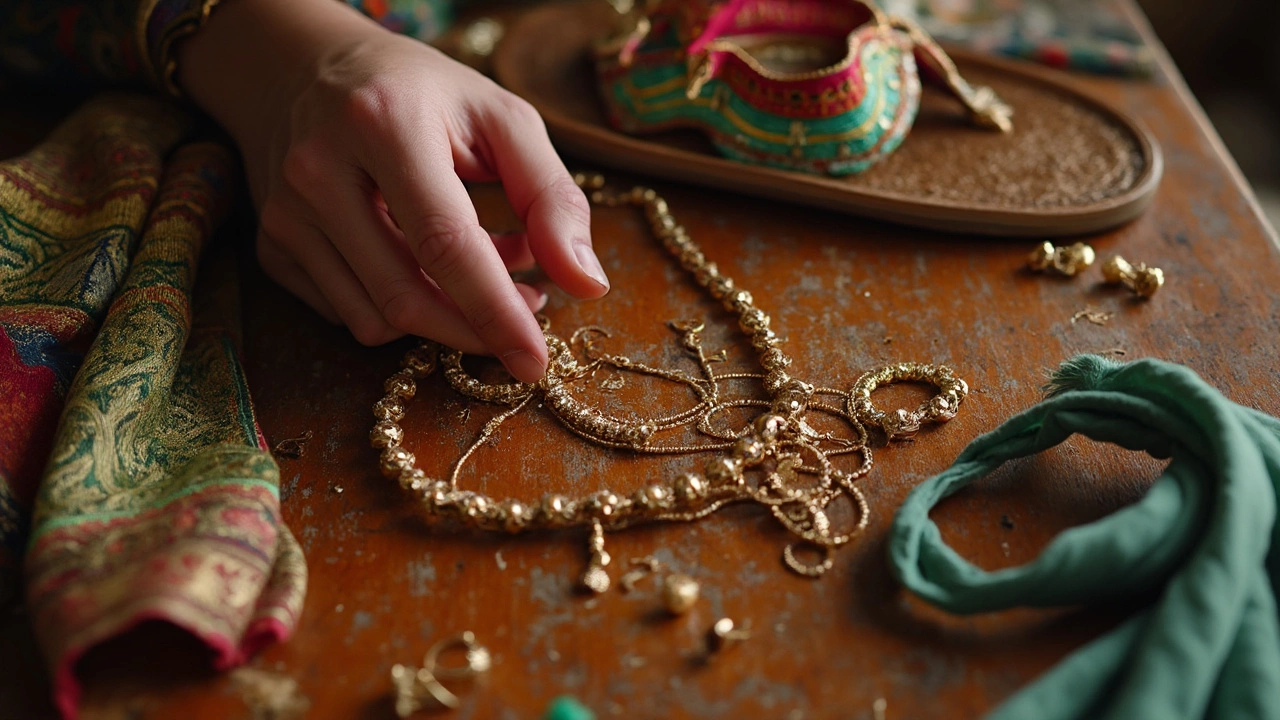
Common Mistakes and How to Avoid Them
Messing up dress etiquette in India happens faster than you think. Some mistakes are obvious—like showing up to a temple in shorts. Others are less clear, like missing the right fashion accessories for a special event. Here’s where people go wrong and how you can do better.
- Wearing Revealing Clothes in the Wrong Places: Crop tops, short skirts, and sleeveless outfits are fine in clubs or college parties in big cities. But try that at a religious site or family event and you’ll get stares, or even denied entry. India values modesty, especially in smaller towns and temples.
- Ignoring the Dress Code for Weddings: Indian weddings love color and bling, but there’s a line. Avoid wearing all white (it's linked to mourning) and skip black at traditional weddings. Men often forget a kurta or Nehru jacket is safer than a T-shirt if you want to blend in and show respect.
- Not Respecting Footwear Rules: You have to leave shoes outside most temples and some homes. A study by Ipsos in 2022 showed almost 85% of urban Indians expect guests to remove shoes indoors. If you’re unsure, just ask.
- Forgetting Key Accessories: Miss out on a dupatta (scarf) or modest jacket, especially for women, and you might feel out of place. Some places even require head coverings, like Sikh gurudwaras.
- Blindly Following Western Trends: India’s fashion is a blend of the traditional and modern, but not every Western trend fits the local context. Loud, flashy brands or micro-mini fashion isn't common in most public spaces.
Here’s a cheat sheet to avoid the common slip-ups:
- Check local norms or the invite for dress suggestions; when in doubt, go for something more traditional.
- Always pack a versatile scarf and some conservative options in your suitcase. Men—carry at least one collared shirt and closed shoes for formal occasions.
- Keep an eye out for shoe racks near doors—if you see them, off with your shoes.
- Learn these keywords: dress etiquette India, traditional clothing, and Indian fashion—these will save you countless awkward moments.
Dress right, carry the right fashion accessories, and pay attention to the vibe of the place. You'll fit in, feel comfortable, and earn respect along the way.
